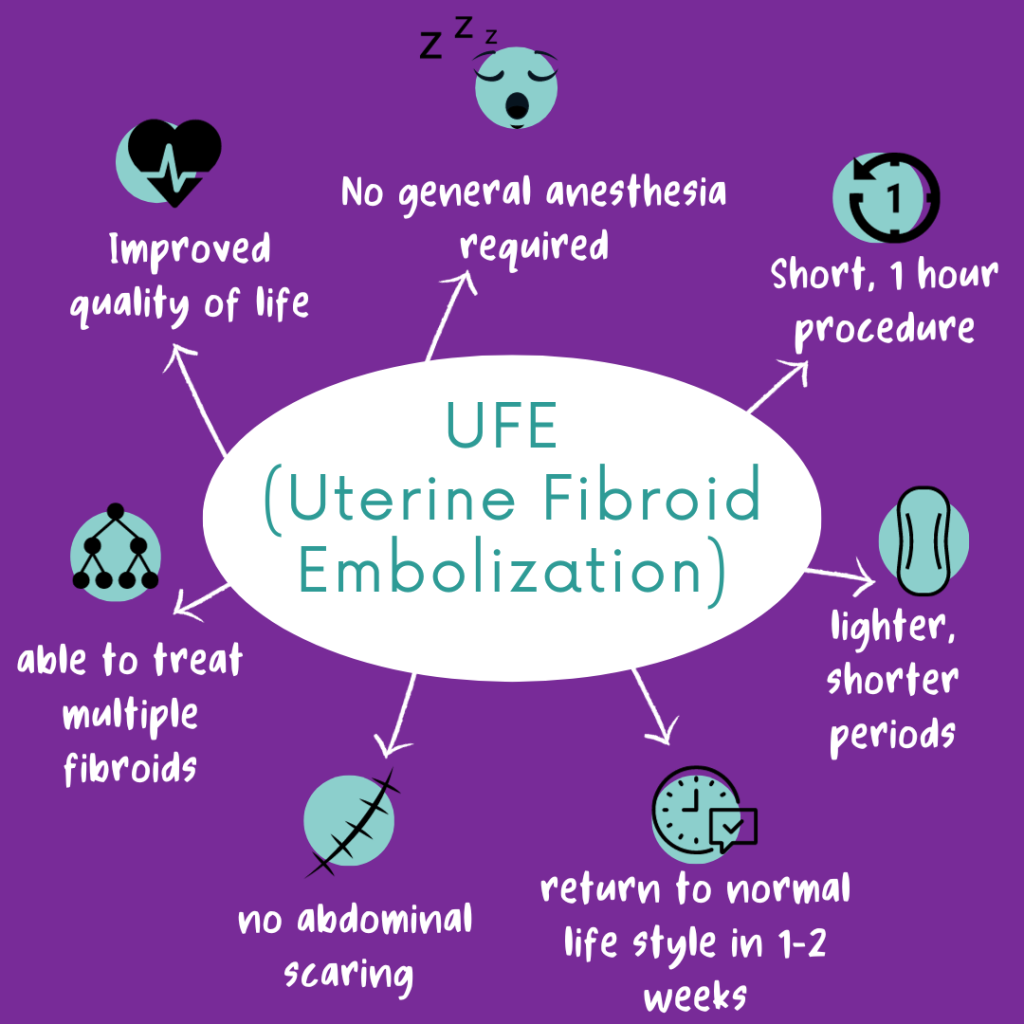
Period After UFE Procedure
Many women considering uterine fibroid embolization (UFE) wonder how the treatment will affect their periods in the future. The first period after UFE is often heavier than usual. Most women who undergo UFE treatment experience significantly lighter and shorter periods within two to three months after treatment. Some women experience irregular menstrual cycles for three to six months as their symptoms improve. In most cases, women no longer suffer from abnormally painful or heavy periods after receiving UFE treatment.
Women sometimes hesitate to undergo fibroid treatment for fear of its impact on various aspects of their health. While this fear is often misplaced, many women avoid treatment and continue suffering from distressing fibroid symptoms. Our goal is to empower women by helping them understand their treatment options. Fibroid treatments like UFE can improve your life while reducing or eliminating fibroid symptoms that affect your period. Our fibroid specialists are eager to answer your questions regarding fibroids and their treatments.
This article discusses the effects UFE can have on periods and menstrual cycles and explains why UFE is considered the gold-standard fibroid treatment.
Should I Consider Getting Fibroids Treated?
We believe all women who suffer from uterine fibroids should consider treatment. Fibroid treatment can alleviate many disruptive symptoms, including heavy periods, severe menstrual cramping, frequent urination, and pain during sex. These symptoms can impact daily activities like work, social engagements, and intimate relations.
Heavy menstrual bleeding is among the most common fibroid symptoms. Women with heavy bleeding might have to change pads or tampons every one to two hours. They may feel the need to be near a bathroom all the time and avoid going outdoors—all of which can take a toll on their emotional well-being. If this sounds all too familiar, fibroid treatment can provide significant relief.

Fibroid treatment can alleviate heavy periods, regulate your menstrual cycle, and improve your quality of life. Although minimally invasive, non-surgical treatments for fibroids like UFE are widely available, many women avoid getting help because they believe a hysterectomy (the complete surgical removal of the uterus) is their only treatment option. We want you to understand that this is rarely the case.
Below, we provide information about UFE treatment and what to expect during your first period after UFE. We also discuss potential changes in your menstrual cycle after UFE. For additional information about UFE or changes to your period after the UFE procedure, consult one of our leading fibroid specialists.
Uterine Fibroid Embolization (UFE)
Uterine fibroid embolization is a minimally invasive, non-surgical fibroid treatment. During the 30–45 minute procedure, tiny particles are injected through a small catheter into the main artery that feeds the targeted fibroid. This permanently blocks blood flow to the fibroid, causing it to shrink and eventually die.
UFE is an office-based treatment performed by a fibroid specialist, known as an interventional radiologist. Before the treatment, you will be given a light sedative to ensure you remain comfortable and relaxed during the procedure. Our specialist will use real-time imaging to guide the catheter. Because there is no surgical incision, you won’t need stitches or experience any scarring—you’ll leave with a single bandaid. Since UFE is an outpatient procedure, you will only need to stay in the office for a short observation period after the treatment before returning home the same day.
As a minimally invasive procedure, UFE involves less pain and risk than fibroid surgeries like hysterectomy and myomectomy. Most women return to their normal daily activities after a short recovery period of one to two weeks. Many report improved fibroid symptoms almost immediately, while others experience gradual improvement over the following weeks and months.
Unlike hysterectomy, uterine fibroid embolization leaves the uterus fully intact, offering premenopausal women the possibility of future pregnancy. If you want to get pregnant after UFE, discuss your plans with a fibroid specialist to determine the best course of treatment.
PREGNANCY AFTER UTERINE FIBROID EMBOLIZATION
First Period After UFE
Fibroids begin shrinking immediately after UFE, but it may take some time before you notice a significant improvement in your symptoms. Thus, your first period after the UFE procedure might be heavy, and you may experience spotting and bleeding between periods for a few weeks. This effect is temporary. Your period bleeding should become lighter with every cycle over the next two to three months.
Many women experience vaginal discharge, bleeding, and spotting in the days and weeks immediately following UFE treatment. In rare cases, women report passing pieces of fibroid, or even whole fibroids, after treatment. This process, known as fibroid expulsion, most often occurs with submucosal fibroids located in the innermost lining of the uterus. Although fibroid expulsion does not generally cause serious issues, there is a slight risk of excessive bleeding, infection, and other complications.
If you have additional questions about what to expect during your first period after UFE, contact your fibroid specialist.
Menstrual Cycles After UFE
Ninety-five percent of patients who have UFE will continue to have periods after the procedure. Women who receive UFE often have lighter and more regular periods over time. Menstrual cramps may also improve and may disappear. UFE can help alleviate other fibroid symptoms as well, such as pain during sex and frequent urination.
If you fall within the age range of menopause (45–55 years), you might have no periods after the UFE procedure. This is not a consequence of the procedure, but a natural result of menopause.
Irregular Periods After UFE
Irregular periods after UFE are common but temporary. Any stress on the body can impact your menstrual cycle. UFE cuts off the blood supply to the fibroid, causing it to shrink gradually. You may notice symptoms improve once the fibroid has disappeared after three to six months. Most women start having regular cycles again around this time.
We understand that the potential for irregular periods after UFE may be a concern if you want to conceive. We encourage you to talk to your fibroid specialist about the best treatment. Our doctors are highly experienced specialists who only treat fibroids, leading to a higher-than-average success rate of 99 percent.
Is it Normal to Miss Your Period After UFE?
 You may miss a period after UFE. It is common to have lighter periods or to miss a period altogether after UFE. This is because the fibroids are no longer producing the hormones that cause heavy bleeding. In some cases, your periods may return to normal after a few months. However, in other cases, your periods may be permanently lighter or stop altogether.
You may miss a period after UFE. It is common to have lighter periods or to miss a period altogether after UFE. This is because the fibroids are no longer producing the hormones that cause heavy bleeding. In some cases, your periods may return to normal after a few months. However, in other cases, your periods may be permanently lighter or stop altogether.
If you are concerned about missing a period after UFE, talk to your doctor. They can help you understand the changes that may occur in your menstrual cycle and offer medical support.
Schedule a Consultation at USA Fibroid Centers
If you suffer from fibroid symptoms like heavy periods, bad cramps, and irregular menstrual cycles, uterine fibroid embolization can help. UFE can quickly shrink your fibroids, providing relief from painful, uncomfortable, and inconvenient symptoms. Most women can return to normal daily activities within one to two weeks.
While there may be some temporary side effects, like missing a period or two and experiencing a lighter or heavier first period after UFE, fibroid symptoms can begin to improve immediately following treatment. You may soon experience lighter periods and regular menstrual cycles after UFE. In addition, UFE preserves fertility.
We offer UFE in dozens of state-of-the-art treatment centers across the country. During an initial consultation with one of our specialists, we can review your medical history, perform a physical exam, and develop a personalized treatment plan.
There is no reason to suffer from symptomatic fibroids any longer. Our primary goal at USA Fibroid Centers is to help women reclaim their lives from the symptoms of uterine fibroids. We’ll discuss all your treatment options so that you can make an informed decision.
To learn more about UFE, your first period after uterine fibroid embolization, and potential changes in your menstrual cycle after UFE, schedule an appointment online.



